
Chapter 22: Being Organized and Steady
22.1 The Body’s Organization
Millions of individual cells of different types come together to make an organism.
Cells of the same type occur within a tissue, while an organ contains different types of tissues.
Tissues are the structural and functional units of the body, and organ systems contain multiple organs that work together to perform a specific function.
The urinary system is an example of an organ system composed of several individual organs, each playing a particular role in the overall process.
The structure of cells, tissues, and organs directly aid function.
Biologists have categorized animal tissues into four major types: epithelial, connective, muscular, and nervous.
Each type of tissue is subdivided into even more types, except for nervous tissue.
This chapter looks at the structure and function of each tissue type, as well as the organs and organ systems where they are used.
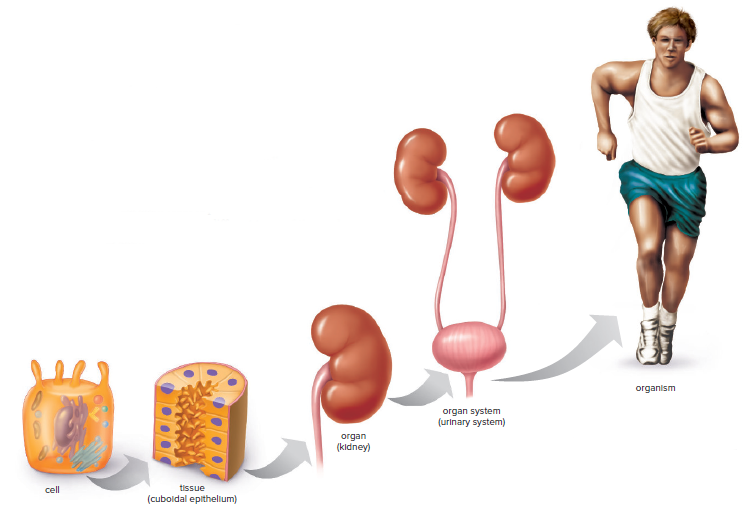
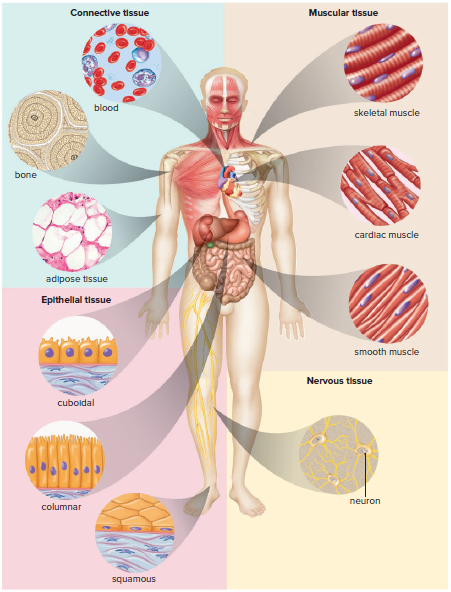
Epithelial Tissue Protects
Epithelial tissue forms external coverings and internal linings of many organs and covers the entire surface of the body.
For a substance to enter or exit the body, it must cross an epithelial tissue.
Epithelial cells adhere to one another, but an epithelium is generally only one cell layer thick.
Cuboidal epithelium lines the kidney tubules and the lumen of a portion of the kidney.
Columnar epithelium lines portions of the lumen of the digestive tract.
Epithelial cells can be classified by the number of layers these cells make in tissues.
A layer that is only one cell thick is referred to as simple.
Multiple layers of cells are called stratified.
Pseudostratified epithelium is a special classification in which the tissue appears to have multiple layers of cells but actually has only one.
Squamous epithelium is composed of thin, flattened cells.
One or more types of epithelial cells are the primary components of glands, which produce and secrete products (mainly hormones).
Epithelial tissue cells can go through mitosis frequently and quickly.
Epithelial tissue is more likely than other tissue types to become cancerous.
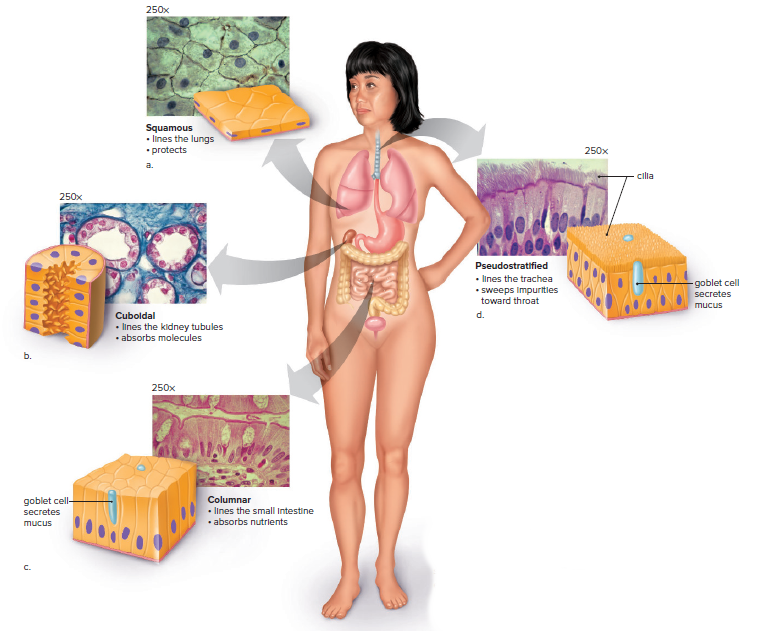
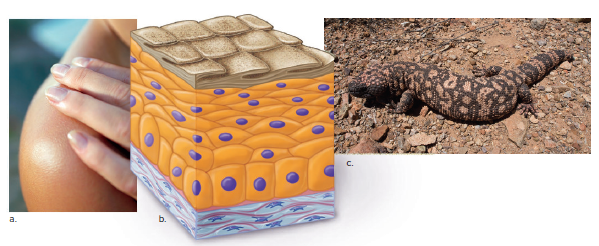
Connective Tissue Connects and Supports
Connective tissue types (Fig. 22.5) bind structures and provide support and protection.
Connective tissue cells are separated by a matrix.
The matrix varies from solid to semifluid to fluid.
The matrix usually contains collagen fibers.
Collagen is the most common protein in the human body.
Collagen is mainly used for structural support.
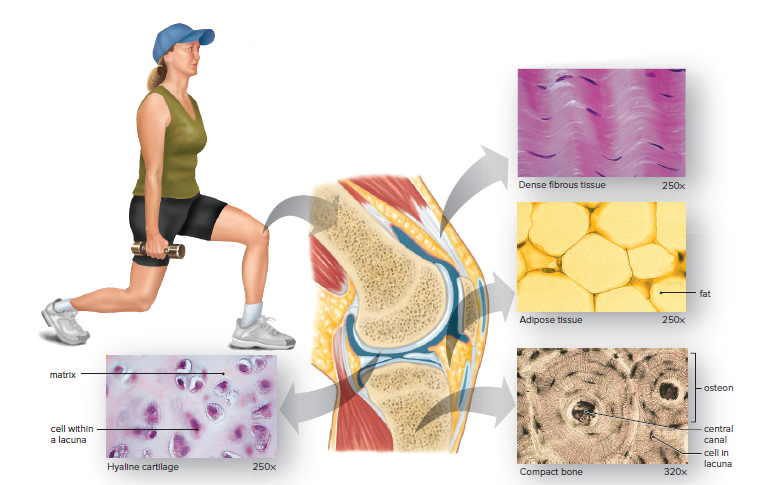
Loose Fibrous and Related Connective Tissues
Loose fibrous connective tissue occurs beneath an epithelium and connects it to other tissues within an organ.
It forms a protective covering for many internal organs, such as muscles, blood vessels, and nerves.
Fibroblasts are the cells that produce a matrix containing fibers, including collagen fibers and elastic fibers.
Loose fibrous connective tissue in the walls of lungs and arteries gives these organs resilience.
Adipose tissue is a type of loose connective tissue in which the fibroblasts enlarge and store fat, and there is limited matrix.
Adipose tissue is located beneath the skin and around organs, such as the heart and kidneys, where it cushions and protects the organs and serves as long-term energy storage.
Dense fibrous connective tissue contains more collagen fibers, which are packed closely together.
Dense fibrous connective tissue is found in tendons, which connect skeletal muscles to bones, and in ligaments, which connect bones to other bones at joints.
Cartilage is made up of cells that lie in small cavities called lacunae, separated by a semisolid yet flexible matrix.
Hyaline cartilage is the most common type of cartilage and contains fine collagen fibers. Its matrix appears white and translucent when unstained.
Hyaline cartilage is found in the nose, ends of long bones and ribs, respiratory passages, and the fetal skeleton.
Cartilage is later replaced by bone, except in cartilaginous fishes like sharks.
Bone is the most rigid connective tissue and consists of an extremely hard matrix of inorganic salts, primarily calcium salts, deposited around collagen fibers.
Inorganic salts give bone rigidity, while collagen fibers provide elasticity and strength.
Compact bone is the most common type of bone in humans and consists of cylindrical structural units called osteons.
Bone cells are located in lacunae between the rings of matrix, and blood vessels in the central canal carry nutrients for bone renewal.
Blood
Blood is composed of cells and plasma.
Matrix in blood is not made by the cells of connective tissue.
Blood is a connective tissue by definition.
Blood has many functions for overall homeostasis of the body.
Blood transports nutrients and oxygen to cells and removes their wastes.
Blood helps distribute heat and plays a role in fluid, ion, and pH balance.
Various components of blood help protect us from disease.
Blood’s ability to clot prevents fluid loss.
Blood contains three formed elements: red blood cells, white blood cells, and platelets.
Red blood cells are small, biconcave, disk-shaped cells without nuclei.
Hemoglobin makes the cells red and binds oxygen to transport it to cells.
White blood cells are usually larger, have a nucleus, and fight infection in two primary ways.
Platelets are fragments of giant cells present only in bone marrow.
Platelets form a plug that seals a damaged blood vessel and release molecules that help the clotting process.
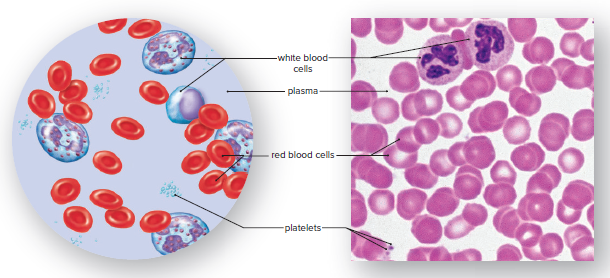
Muscular Tissue Moves the Body
Muscular tissue and nervous tissue work together to enable animals to move.
Muscular tissue contains contractile protein filaments, called actin and myosin filaments, that interact to produce movement.
The three types of vertebrate muscles are skeletal, cardiac, and smooth.
Skeletal muscle is attached by tendons to the bones of the skeleton, and when it contracts, bones move.
Contraction of skeletal muscle occurs faster than in the other two muscle types and is under voluntary control.
The cells of skeletal muscle, called fibers, are cylindrical and quite long, and have multiple nuclei.
The fibers have alternating light and dark bands running across the cell, giving them a striated appearance.
Cardiac muscle is found only in the walls of the heart, and its contraction pumps blood and accounts for the heartbeat.
Like skeletal muscle, cardiac muscle has striations, but the contraction of the heart is autorhythmic and involuntary.
Cardiac muscle cells have a single, centrally placed nucleus and are branched and seemingly fused with one another.
Smooth muscle is named because the cells lack striations and form layers in which the thick middle portion of one cell is opposite the thin ends of adjacent cells.
Smooth muscle is involuntary and is found in the walls of the viscera and blood vessels.
Smooth muscle contracts more slowly than skeletal muscle but can remain contracted for a longer time.
Nervous Tissue Communicates
Nervous tissue coordinates body functions and responses to internal and external environments.
The nervous system depends on sensory input, integration of data, and motor output.
Nerves conduct impulses from sensory receptors to the spinal cord and brain for integration.
Sensation occurs only in the brain.
Nerves conduct impulses away from the spinal cord and brain to muscles and glands for response.
Neuron has three parts: dendrites, cell body, and axon.
Dendrites conduct signals toward the cell body.
The cell body contains cytoplasm and a nucleus.
Axon conducts nerve impulses away from the cell body to other cells.
The brain and spinal cord contain many neurons, while nerves contain bundles of axons.
Neuroglia support and nourish neurons, outnumbering neurons 9 to 1.
Schwann cells are a type of neuroglia that form a protective coating called myelin sheath on axons.
Myelin sheaths insulate axons and allow nerve impulses to travel more quickly.
22.2 Organs and Organ Systems
Organs are composed of multiple tissues.
The structure and function of an organ depend on its tissues.
An organ can perform a function that none of its tissues can do alone.
The bladder's function is to store and expel urine.
The bladder's function is dependent on its individual tissues.
The bladder's epithelium lining helps store urine and prevents leakage.
The bladder's muscles propel urine into the urethra for removal.
Organ systems' functions depend on their organs.
The urinary system produces, stores, and transports urine.
The kidneys produce urine, the bladder stores it, and tubes transport it.
The body's systems are divided into 5 categories.
These systems contribute to homeostasis, the constancy of the internal environment.
Transport and Protection
The cardiovascular system:
Consists of blood, heart, and blood vessels.
Transports nutrients and oxygen to interstitial fluid for cells.
Removes waste molecules from interstitial fluid.
Surrounds the body's cells with interstitial fluid.
The lymphatic system:
Consists of lymphatic vessels, lymph, lymph nodes, and other lymphatic organs.
Absorbs fat from the digestive system.
Collects excess interstitial fluid.
Returns excess fluid to the blood in the cardiovascular system.
Both systems:
Involved in protecting the body against disease.
Certain cells in the lymph and blood are part of the immune system.
Along with the thymus and spleen, specifically protect the body from disease.
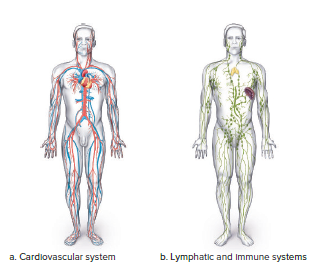
Maintenance of the Body
Three systems (respiratory, urinary, and digestive) add or remove substances from the blood.
If blood composition remains constant, so does that of the interstitial fluid.
The respiratory system consists of the lungs, trachea, and other structures that take air to and from the lungs.
The respiratory system brings oxygen into the body and takes carbon dioxide out through the lungs.
Respiratory system exchanges gases with the blood.
The urinary system consists of kidneys, a urinary bladder, and structures that transport urine.
The urinary system rids the blood of wastes and helps regulate the fluid level and the chemical content of the blood.
The digestive system consists of organs along the digestive tract, teeth, salivary glands, liver, and pancreas.
The digestive system receives food and digests it into nutrient molecules.
Nutrient molecules then enter the blood.
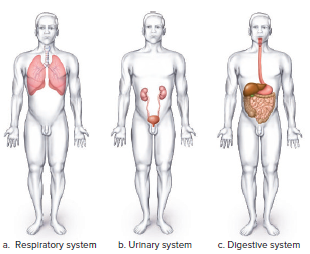
Control
The nervous system includes the brain, spinal cord, and associated nerves.
Nerves conduct nerve impulses from receptors to the brain and spinal cord and from the brain and spinal cord to muscles and glands.
Sensory receptors and sense organs are sometimes considered part of the nervous system.
The endocrine system consists of hormonal glands, such as the thyroid and adrenal glands, which secrete hormones.
Hormones serve as messengers between body parts.
Both the nervous and endocrine systems coordinate and regulate the functions of the body's other systems.
The nervous system causes quick responses, while the endocrine system's responses tend to last longer.
The endocrine system helps maintain the proper functioning of the male and female reproductive organs.
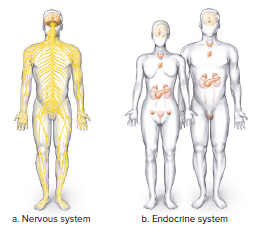
Sensory Input and Motor Output
The integumentary system:
Consists of the skin and its accessory structures.
Contains sensory receptors that respond to external stimuli.
Communicates with the brain and spinal cord via nerve fibers.
It may cause the brain to respond to a stimulus.
The skeletal system:
Enables movement of body parts.
Serves as a place of attachment for skeletal muscles.
Protects body parts, such as the skull for the brain and rib cage for the heart and lungs.
The muscular system:
Accounts for the movement of body parts.
Works with the skeletal system to enable movement.
All three systems:
Protect and support the body.
Work together to enable movement and respond to external stimuli.
Are essential for overall body function.
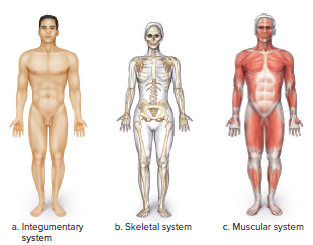
Reproduction
The reproductive system involves different organs in males and females.
The male reproductive system consists of:
Testes
Other glands.
Various ducts, such as the ductus deferens.
Conducts semen to and through the penis.
Testes produce sex cells called sperm.
The female reproductive system consists of:
Ovaries.
Uterine tubes.
Uterus.
Vagina.
External genitals.
Ovaries produce sex cells called eggs.
Fertilization of an egg by a sperm leads to the development of offspring.
22.3 Homeostasis
External environment: everything outside the body.
Internal environment: cells, tissues, fluids, and organs.
Cells live in interstitial fluid, which is constantly renewed with nutrients and gases via exchanges with the blood.
Blood and interstitial fluid constitute part of the body’s internal environment.
Volume and composition of interstitial fluid remain relatively constant as long as blood composition remains near normal levels.
Maintenance of the relatively constant condition of the internal environment within acceptable ranges is called homeostasis.
Homeostasis keeps internal conditions within a narrow range despite external changes.
Examples: body temperature maintained near 37°C, blood pH stays about 7.4 even after eating acidic foods, and blood sugar remain at about 0.1% even after eating a candy bar.
Organ Systems and Homeostasis
All systems of the body contribute to maintaining homeostasis.
The cardiovascular system conducts blood to and away from capillaries.
Red blood cells transport oxygen and participate in the transport of carbon dioxide.
White blood cells fight infection, and platelets participate in the clotting process.
Lymphatic capillaries collect excess interstitial fluid and return it via lymphatic vessels to the cardiovascular system.
Lymph nodes help purify lymph and keep it free of pathogens.
The digestive system takes in and digests food, providing nutrient molecules that enter the blood to replace those that are constantly being used by the body’s cells.
The respiratory system removes carbon dioxide from and adds oxygen to the blood.
Kidneys remove metabolic wastes and regulate blood volume, salt balance, and pH.
The liver regulates the glucose concentration of the blood, removes excess glucose from the blood for storage as glycogen, and makes urea, a nitrogenous end product of protein metabolism.
The nervous and endocrine systems regulate the other systems of the body.
Sensory receptors send nerve impulses to control centers in the brain, which then direct effectors (muscles or glands) to become active.
Endocrine glands secrete hormones that bring about slower, more lasting changes that keep the internal environment relatively stable.
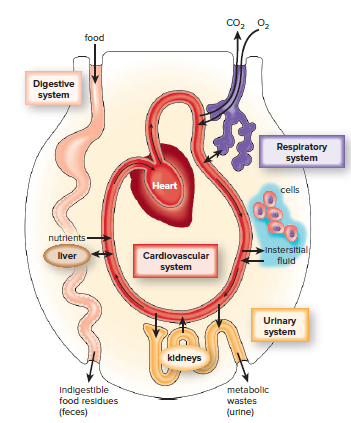
Negative Feedback
Negative feedback is the primary homeostatic mechanism that maintains internal environment stability.
The negative feedback mechanism has two components: the sensor and the control center.
The sensor detects a change in the internal environment (stimulus).
The control center initiates an effect that brings conditions back to normal.
The negative feedback mechanism is present when the output of the system dampens the original stimulus.
Example: Pancreas secretes insulin when the blood glucose level is too high, causing cells to take up glucose and return the blood sugar level to normal.
When feedback mechanisms cannot compensate, illness results.
Example: In diabetes mellitus, the pancreas is unable to produce insulin, causing dangerously high blood sugar levels and serious illness.
The study of homeostatic mechanisms is medically important.
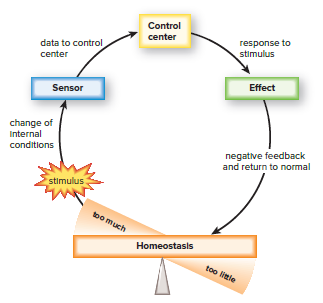
Mechanical Example
A home heating system is used to illustrate a negative feedback mechanism.
The thermostat is set at 20°C (68°F), which is the set point.
The thermostat has a thermometer that detects when the room temperature is above or below the set point.
The thermostat also has a control center that turns the furnace off when the room is warm and turns it on when the room is cool.
When the furnace is off, the room cools down a bit, and when the furnace is on, the room warms up a bit.
This results in fluctuation above and below the set point due to the negative feedback system.
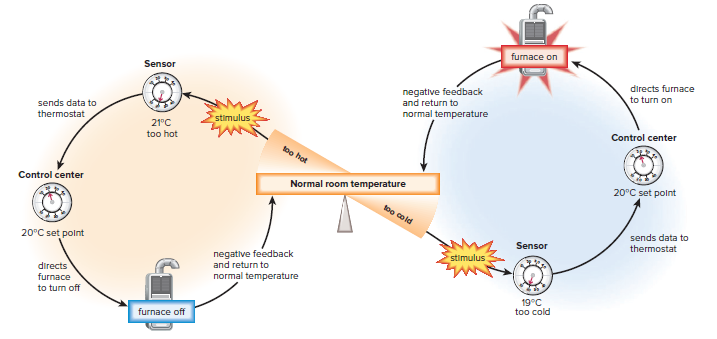
Human Example: Regulation of Body Temperature
The thermostat for body temperature is located in the hypothalamus.
When the core body temperature falls below normal, the control center directs the blood vessels of the skin to constrict, conserving heat.
If the core body temperature falls even lower, the control center sends nerve impulses to the skeletal muscles, and shivering occurs.
Shivering generates heat, and gradually body temperature rises toward 37°C (98.6°F).
When the temperature rises to normal, the control center is inactivated.
When body temperature is higher than normal, the control center directs the blood vessels of the skin to dilate.
More blood is then able to flow near the surface of the body, where heat can be lost to the environment.
The nervous system activates the sweat glands, and the evaporation of sweat helps lower body temperature.
Gradually, body temperature decreases to 37°C (98.6°F).
A negative feedback mechanism prevents continued change in the same direction.
Body temperature does not get warmer and warmer because warmth stimulates changes that decrease body temperature.
Body temperature does not get colder and colder because a body temperature below normal causes changes that bring body temperature up.
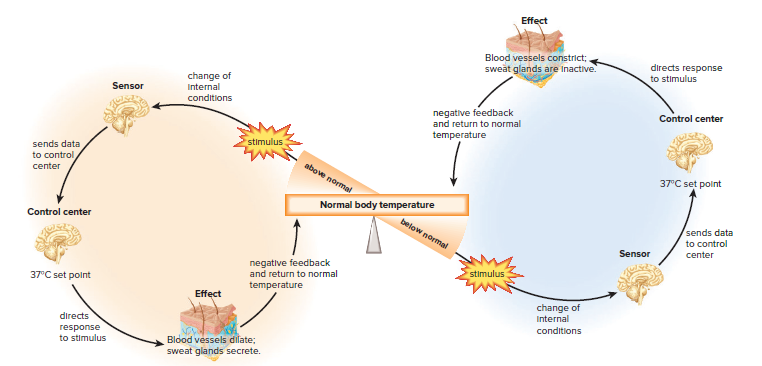
Chapter 22: Being Organized and Steady
22.1 The Body’s Organization
Millions of individual cells of different types come together to make an organism.
Cells of the same type occur within a tissue, while an organ contains different types of tissues.
Tissues are the structural and functional units of the body, and organ systems contain multiple organs that work together to perform a specific function.
The urinary system is an example of an organ system composed of several individual organs, each playing a particular role in the overall process.
The structure of cells, tissues, and organs directly aid function.
Biologists have categorized animal tissues into four major types: epithelial, connective, muscular, and nervous.
Each type of tissue is subdivided into even more types, except for nervous tissue.
This chapter looks at the structure and function of each tissue type, as well as the organs and organ systems where they are used.


Epithelial Tissue Protects
Epithelial tissue forms external coverings and internal linings of many organs and covers the entire surface of the body.
For a substance to enter or exit the body, it must cross an epithelial tissue.
Epithelial cells adhere to one another, but an epithelium is generally only one cell layer thick.
Cuboidal epithelium lines the kidney tubules and the lumen of a portion of the kidney.
Columnar epithelium lines portions of the lumen of the digestive tract.
Epithelial cells can be classified by the number of layers these cells make in tissues.
A layer that is only one cell thick is referred to as simple.
Multiple layers of cells are called stratified.
Pseudostratified epithelium is a special classification in which the tissue appears to have multiple layers of cells but actually has only one.
Squamous epithelium is composed of thin, flattened cells.
One or more types of epithelial cells are the primary components of glands, which produce and secrete products (mainly hormones).
Epithelial tissue cells can go through mitosis frequently and quickly.
Epithelial tissue is more likely than other tissue types to become cancerous.


Connective Tissue Connects and Supports
Connective tissue types (Fig. 22.5) bind structures and provide support and protection.
Connective tissue cells are separated by a matrix.
The matrix varies from solid to semifluid to fluid.
The matrix usually contains collagen fibers.
Collagen is the most common protein in the human body.
Collagen is mainly used for structural support.

Loose Fibrous and Related Connective Tissues
Loose fibrous connective tissue occurs beneath an epithelium and connects it to other tissues within an organ.
It forms a protective covering for many internal organs, such as muscles, blood vessels, and nerves.
Fibroblasts are the cells that produce a matrix containing fibers, including collagen fibers and elastic fibers.
Loose fibrous connective tissue in the walls of lungs and arteries gives these organs resilience.
Adipose tissue is a type of loose connective tissue in which the fibroblasts enlarge and store fat, and there is limited matrix.
Adipose tissue is located beneath the skin and around organs, such as the heart and kidneys, where it cushions and protects the organs and serves as long-term energy storage.
Dense fibrous connective tissue contains more collagen fibers, which are packed closely together.
Dense fibrous connective tissue is found in tendons, which connect skeletal muscles to bones, and in ligaments, which connect bones to other bones at joints.
Cartilage is made up of cells that lie in small cavities called lacunae, separated by a semisolid yet flexible matrix.
Hyaline cartilage is the most common type of cartilage and contains fine collagen fibers. Its matrix appears white and translucent when unstained.
Hyaline cartilage is found in the nose, ends of long bones and ribs, respiratory passages, and the fetal skeleton.
Cartilage is later replaced by bone, except in cartilaginous fishes like sharks.
Bone is the most rigid connective tissue and consists of an extremely hard matrix of inorganic salts, primarily calcium salts, deposited around collagen fibers.
Inorganic salts give bone rigidity, while collagen fibers provide elasticity and strength.
Compact bone is the most common type of bone in humans and consists of cylindrical structural units called osteons.
Bone cells are located in lacunae between the rings of matrix, and blood vessels in the central canal carry nutrients for bone renewal.
Blood
Blood is composed of cells and plasma.
Matrix in blood is not made by the cells of connective tissue.
Blood is a connective tissue by definition.
Blood has many functions for overall homeostasis of the body.
Blood transports nutrients and oxygen to cells and removes their wastes.
Blood helps distribute heat and plays a role in fluid, ion, and pH balance.
Various components of blood help protect us from disease.
Blood’s ability to clot prevents fluid loss.
Blood contains three formed elements: red blood cells, white blood cells, and platelets.
Red blood cells are small, biconcave, disk-shaped cells without nuclei.
Hemoglobin makes the cells red and binds oxygen to transport it to cells.
White blood cells are usually larger, have a nucleus, and fight infection in two primary ways.
Platelets are fragments of giant cells present only in bone marrow.
Platelets form a plug that seals a damaged blood vessel and release molecules that help the clotting process.

Muscular Tissue Moves the Body
Muscular tissue and nervous tissue work together to enable animals to move.
Muscular tissue contains contractile protein filaments, called actin and myosin filaments, that interact to produce movement.
The three types of vertebrate muscles are skeletal, cardiac, and smooth.
Skeletal muscle is attached by tendons to the bones of the skeleton, and when it contracts, bones move.
Contraction of skeletal muscle occurs faster than in the other two muscle types and is under voluntary control.
The cells of skeletal muscle, called fibers, are cylindrical and quite long, and have multiple nuclei.
The fibers have alternating light and dark bands running across the cell, giving them a striated appearance.
Cardiac muscle is found only in the walls of the heart, and its contraction pumps blood and accounts for the heartbeat.
Like skeletal muscle, cardiac muscle has striations, but the contraction of the heart is autorhythmic and involuntary.
Cardiac muscle cells have a single, centrally placed nucleus and are branched and seemingly fused with one another.
Smooth muscle is named because the cells lack striations and form layers in which the thick middle portion of one cell is opposite the thin ends of adjacent cells.
Smooth muscle is involuntary and is found in the walls of the viscera and blood vessels.
Smooth muscle contracts more slowly than skeletal muscle but can remain contracted for a longer time.
Nervous Tissue Communicates
Nervous tissue coordinates body functions and responses to internal and external environments.
The nervous system depends on sensory input, integration of data, and motor output.
Nerves conduct impulses from sensory receptors to the spinal cord and brain for integration.
Sensation occurs only in the brain.
Nerves conduct impulses away from the spinal cord and brain to muscles and glands for response.
Neuron has three parts: dendrites, cell body, and axon.
Dendrites conduct signals toward the cell body.
The cell body contains cytoplasm and a nucleus.
Axon conducts nerve impulses away from the cell body to other cells.
The brain and spinal cord contain many neurons, while nerves contain bundles of axons.
Neuroglia support and nourish neurons, outnumbering neurons 9 to 1.
Schwann cells are a type of neuroglia that form a protective coating called myelin sheath on axons.
Myelin sheaths insulate axons and allow nerve impulses to travel more quickly.
22.2 Organs and Organ Systems
Organs are composed of multiple tissues.
The structure and function of an organ depend on its tissues.
An organ can perform a function that none of its tissues can do alone.
The bladder's function is to store and expel urine.
The bladder's function is dependent on its individual tissues.
The bladder's epithelium lining helps store urine and prevents leakage.
The bladder's muscles propel urine into the urethra for removal.
Organ systems' functions depend on their organs.
The urinary system produces, stores, and transports urine.
The kidneys produce urine, the bladder stores it, and tubes transport it.
The body's systems are divided into 5 categories.
These systems contribute to homeostasis, the constancy of the internal environment.
Transport and Protection
The cardiovascular system:
Consists of blood, heart, and blood vessels.
Transports nutrients and oxygen to interstitial fluid for cells.
Removes waste molecules from interstitial fluid.
Surrounds the body's cells with interstitial fluid.
The lymphatic system:
Consists of lymphatic vessels, lymph, lymph nodes, and other lymphatic organs.
Absorbs fat from the digestive system.
Collects excess interstitial fluid.
Returns excess fluid to the blood in the cardiovascular system.
Both systems:
Involved in protecting the body against disease.
Certain cells in the lymph and blood are part of the immune system.
Along with the thymus and spleen, specifically protect the body from disease.

Maintenance of the Body
Three systems (respiratory, urinary, and digestive) add or remove substances from the blood.
If blood composition remains constant, so does that of the interstitial fluid.
The respiratory system consists of the lungs, trachea, and other structures that take air to and from the lungs.
The respiratory system brings oxygen into the body and takes carbon dioxide out through the lungs.
Respiratory system exchanges gases with the blood.
The urinary system consists of kidneys, a urinary bladder, and structures that transport urine.
The urinary system rids the blood of wastes and helps regulate the fluid level and the chemical content of the blood.
The digestive system consists of organs along the digestive tract, teeth, salivary glands, liver, and pancreas.
The digestive system receives food and digests it into nutrient molecules.
Nutrient molecules then enter the blood.

Control
The nervous system includes the brain, spinal cord, and associated nerves.
Nerves conduct nerve impulses from receptors to the brain and spinal cord and from the brain and spinal cord to muscles and glands.
Sensory receptors and sense organs are sometimes considered part of the nervous system.
The endocrine system consists of hormonal glands, such as the thyroid and adrenal glands, which secrete hormones.
Hormones serve as messengers between body parts.
Both the nervous and endocrine systems coordinate and regulate the functions of the body's other systems.
The nervous system causes quick responses, while the endocrine system's responses tend to last longer.
The endocrine system helps maintain the proper functioning of the male and female reproductive organs.

Sensory Input and Motor Output
The integumentary system:
Consists of the skin and its accessory structures.
Contains sensory receptors that respond to external stimuli.
Communicates with the brain and spinal cord via nerve fibers.
It may cause the brain to respond to a stimulus.
The skeletal system:
Enables movement of body parts.
Serves as a place of attachment for skeletal muscles.
Protects body parts, such as the skull for the brain and rib cage for the heart and lungs.
The muscular system:
Accounts for the movement of body parts.
Works with the skeletal system to enable movement.
All three systems:
Protect and support the body.
Work together to enable movement and respond to external stimuli.
Are essential for overall body function.

Reproduction
The reproductive system involves different organs in males and females.
The male reproductive system consists of:
Testes
Other glands.
Various ducts, such as the ductus deferens.
Conducts semen to and through the penis.
Testes produce sex cells called sperm.
The female reproductive system consists of:
Ovaries.
Uterine tubes.
Uterus.
Vagina.
External genitals.
Ovaries produce sex cells called eggs.
Fertilization of an egg by a sperm leads to the development of offspring.
22.3 Homeostasis
External environment: everything outside the body.
Internal environment: cells, tissues, fluids, and organs.
Cells live in interstitial fluid, which is constantly renewed with nutrients and gases via exchanges with the blood.
Blood and interstitial fluid constitute part of the body’s internal environment.
Volume and composition of interstitial fluid remain relatively constant as long as blood composition remains near normal levels.
Maintenance of the relatively constant condition of the internal environment within acceptable ranges is called homeostasis.
Homeostasis keeps internal conditions within a narrow range despite external changes.
Examples: body temperature maintained near 37°C, blood pH stays about 7.4 even after eating acidic foods, and blood sugar remain at about 0.1% even after eating a candy bar.
Organ Systems and Homeostasis
All systems of the body contribute to maintaining homeostasis.
The cardiovascular system conducts blood to and away from capillaries.
Red blood cells transport oxygen and participate in the transport of carbon dioxide.
White blood cells fight infection, and platelets participate in the clotting process.
Lymphatic capillaries collect excess interstitial fluid and return it via lymphatic vessels to the cardiovascular system.
Lymph nodes help purify lymph and keep it free of pathogens.
The digestive system takes in and digests food, providing nutrient molecules that enter the blood to replace those that are constantly being used by the body’s cells.
The respiratory system removes carbon dioxide from and adds oxygen to the blood.
Kidneys remove metabolic wastes and regulate blood volume, salt balance, and pH.
The liver regulates the glucose concentration of the blood, removes excess glucose from the blood for storage as glycogen, and makes urea, a nitrogenous end product of protein metabolism.
The nervous and endocrine systems regulate the other systems of the body.
Sensory receptors send nerve impulses to control centers in the brain, which then direct effectors (muscles or glands) to become active.
Endocrine glands secrete hormones that bring about slower, more lasting changes that keep the internal environment relatively stable.

Negative Feedback
Negative feedback is the primary homeostatic mechanism that maintains internal environment stability.
The negative feedback mechanism has two components: the sensor and the control center.
The sensor detects a change in the internal environment (stimulus).
The control center initiates an effect that brings conditions back to normal.
The negative feedback mechanism is present when the output of the system dampens the original stimulus.
Example: Pancreas secretes insulin when the blood glucose level is too high, causing cells to take up glucose and return the blood sugar level to normal.
When feedback mechanisms cannot compensate, illness results.
Example: In diabetes mellitus, the pancreas is unable to produce insulin, causing dangerously high blood sugar levels and serious illness.
The study of homeostatic mechanisms is medically important.

Mechanical Example
A home heating system is used to illustrate a negative feedback mechanism.
The thermostat is set at 20°C (68°F), which is the set point.
The thermostat has a thermometer that detects when the room temperature is above or below the set point.
The thermostat also has a control center that turns the furnace off when the room is warm and turns it on when the room is cool.
When the furnace is off, the room cools down a bit, and when the furnace is on, the room warms up a bit.
This results in fluctuation above and below the set point due to the negative feedback system.

Human Example: Regulation of Body Temperature
The thermostat for body temperature is located in the hypothalamus.
When the core body temperature falls below normal, the control center directs the blood vessels of the skin to constrict, conserving heat.
If the core body temperature falls even lower, the control center sends nerve impulses to the skeletal muscles, and shivering occurs.
Shivering generates heat, and gradually body temperature rises toward 37°C (98.6°F).
When the temperature rises to normal, the control center is inactivated.
When body temperature is higher than normal, the control center directs the blood vessels of the skin to dilate.
More blood is then able to flow near the surface of the body, where heat can be lost to the environment.
The nervous system activates the sweat glands, and the evaporation of sweat helps lower body temperature.
Gradually, body temperature decreases to 37°C (98.6°F).
A negative feedback mechanism prevents continued change in the same direction.
Body temperature does not get warmer and warmer because warmth stimulates changes that decrease body temperature.
Body temperature does not get colder and colder because a body temperature below normal causes changes that bring body temperature up.

 Knowt
Knowt
